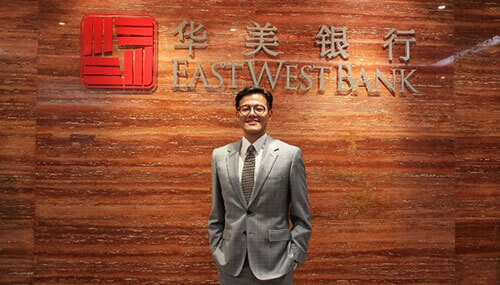U.S.-Asia Business
Traditional Banking and Fintech Unite to Improve Business Cash Flow
By Melody Yuan

Supply chain and new models of financing at the intersection of banking and technology.
Fintech companies bring innovation, agility and advanced digital infrastructures to the table, whereas traditional banks typically have deeper pockets, knowledge of compliance and financial regulation, and a stable distribution network. With their strengths combined, collaboration seems like a no-brainer, and the World Fintech Report 2018 has reported that more than 75 percent of fintech firms have identified their primary business objective as collaborating with traditional companies to strengthen business models, drive innovation and retain customer trust. “In recent years, fintech has become a heated topic in the financial industry,” says David Chang, head of innovation banking in China at East West Bank. “The debate is always on finance and technology, but which comes first?”
With more than 80 percent of China’s registered businesses being small to mid-size enterprises (SMEs), they have become a force that cannot be ignored. Despite their sheer numbers, it remains a challenge for these business owners to qualify for loans and to maintain regular cash flow. According to the World Bank’s research, more than 50 percent of SMEs globally lack access to credit, with the total credit gap for SMEs being as high as $2.6 trillion. Their small scale of operation and lower margins of retained profits make it difficult for them to borrow from a traditional bank. Without legal guarantees from private lending, and the high costs involved with listing IPOs, finding stable and sustainable methods of financing can be a major roadblock.
The solution? Enter supply chain finance. “Supply chain finance is more focused on judging a company in a three-dimensional way, rather than simply focusing on financial statement figures,” says Roy Yan, managing director of Mic Finance, a fintech firm in China. “Under this financial model, lenders look at the past and future performance of a company, and cash flow efficiency between buyers and suppliers, which are factors that can be easily overlooked by the traditional financial model.”
The role of banks and fintechs in supply chain finance
Supply chain finance is a technology-based transaction that helps alleviate cash flow to SMEs by essentially prolonging their payment period to suppliers. Under this transaction, suppliers can sell their invoices at a discount to banks or other financial service providers; in return, they get a faster turnaround on the money they are owed, while the buyers are given more time to pay back.
According to Tom Beckwith, a management consultant at BCS Consulting, “in practice, supply chain financing involves a supplier selling its invoices to a financial services provider at a discount, with the bank assured of payment from the buyer on a later date.” This guarantee frees up any financial bottlenecks or blockages, and allows for more available cash for both the buyer and the supplier.
While the supply chain finance model has been around for years, technology has made the process more seamless. From cloud-based platforms creating a marketplace for onboarding suppliers and buyers, to demonstrating more transparency and providing powerful analytics for businesses, improvements in the process encourage more collaboration across businesses. “Supply chain finance, as an alternative to peer-to-peer lending for SMEs, is similarly ripe for disruption,” says Beckwith. “The incumbent banks that recognize this will be those who dominate the trade finance landscape in the years to come.” Fintech firms are especially adept at offering these technological services, and are quickly catching on to the trend by connecting companies to a large set of funders and suppliers.
"This new model of financing will solve a lot of problems for SMEs, and as someone who works in traditional banking, I’d rather look at this as an opportunity for innovation, rather than an industry threat."

“This trend is only the beginning. This new model of financing will solve a lot of problems for SMEs, and as someone who works in traditional banking,” says Chang, “I’d rather look at this as an opportunity for innovation, rather than an industry threat.”
Fintech firms like Mic Finance have helped companies of all sizes gain access to other services as well, such as accounts receivables financing, order financing and inventory financing. “We effectively aid businesses by collecting key data and applying it to develop financing options and analyze risk control through implementing blockchain technology,” says Yan. “All of these technology advancements and changes are happening in the marketplace, and we’ve partnered with East West Bank to grab business opportunities emerging at the forefront of this giant wave of financial innovation.”
Successful collaboration model
East West Bank and Mic Finance exemplify a successful financial collaboration across borders. Based in Shanghai, Mic Finance is a digital financial service platform that engages mainly in internet equity investment financing, angel capital, venture capital, and other forms of business financing services. Most recently, the company helped finance one of China’s biggest technology companies, Xiaomi Corporation. Founded in 2010, Xiaomi is a leading tech and electronics company from Beijing that has gained tremendous market share through their innovative and affordable consumer products. According to a recent data reported by CNBC, Xiaomi is the fourth-largest smartphone maker in the world and is looking to expand beyond China and the Asia markets. The company also reported a 68 percent revenue increase and $2.1 billion profit for the second quarter of 2018, after its IPO in Hong Kong.
“The partnership between Mic Finance and East West Bank is an innovative attempt,” says Yan. “East West Bank provides financial services directly to Xiaomi’s eco-chain enterprises, and works with Mic Finance to collect and manage company data.” Understanding the customer’s cash flow volatility, and addressing it by increasing working capital and reducing supply chain risks allow for these businesses to focus more on growing their bottom line. In addition, digitally active business owners increasingly expect to make seamless digital transactions, such as payments and money transfers.
Data analytics, system efficiency, and more transparency in the form of a digital paper trail also encourage business owners to explore options with fintech firms. “In collaboration with East West Bank, at Mic Finance we use the sales data on Xiaomi’s e-commerce platform to demonstrate the enterprise’s rate of success and provide financing support,” says Yan. “This solution is known as a data loan and is an innovative solution brought forth by the East West Bank team.”
As Xiaomi looks to expand overseas, they will increasingly rely on the technologies and digital applications provided by their financiers. “Through this partnership, East West Bank gets new customers, Mic Finance gets to leverage their technology, and Xiaomi receives the financial support they need. It’s a win-win situation for all three parties,” says Chang. “Our team will continue to explore broadly through the value chain to provide financing solution to clients across their cash cycle.”
For SMEs, approaching a fintech firm to provide innovative solutions and access to funds seems to be the immediate remedy. However, finding a fintech firm that has a proven track record with a traditional bank will yield more scalable long-term results.

